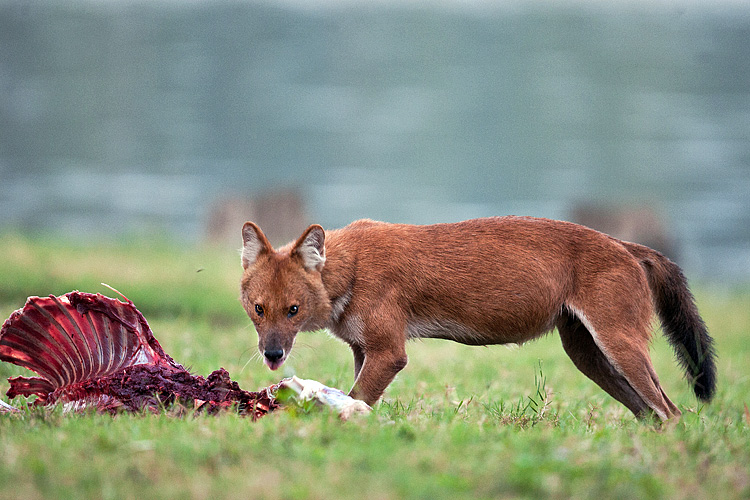As umbrella species, the tiger and its co-predators, the leopard and dhole play a fundamental role in shaping prey communities in the forest. Understanding the food habits and dietary seperation of these three large carnivores is vital for conservation of prey species and overall ecosystem functioning.
Authors Anish P. Andheria, K. Ullas Karanth and N. Samba Kumar conducted a study of diets of three sympatric large carnivores, the tiger (Panthera tigris), the leopard (Panthera pardus) and the dhole (Cuon alpinus) in Bandipur Tiger Reserve, Karnataka. These are the highlights from their study published in the Journal of Zoology in 2007. You can download the paper from the link provided.
Study area
The study was conducted in the 880 sq km Bandipur Tiger Reserve, Karnataka, which receives an annual rainfall of 625-1250 mm and temperatures range between 1-29°C. The dry deciduous forest receives water from rivers Moyar, Nugu and Kabini and its tributaries. It supports many herbivore species such as chital, sambar, gaur, wild pig, muntjac, chevrotain and four-horned antelope and other species like hanuman langur, bonnet macaque, black-naped hare, and porcupine.
Methods
- Two sampling methods were adopted to identify scats of the predator species. In extensive sampling (42 days), 18-scat routes covering 235 km were sampled six times between March 6 and April 16, 2006 covering a total of 1412 km of forest roads. In the intensive sampling (12 days) six routes were sampled 12 times per day between April 19 and April 30, 2006 covering a total of 920 km of road. Both methods allowed estimation of scat deposition rates.
- The scats of the three predators were collected and DNA fecal tests were conducted to confirm the accuracy of identification. Scats containing adequate amount of prey remains (hair, undigested body parts) were stored and processed. This being the primary source of identification, prey species were classified based on appearance of hair, color, texture, basal configuration, cortex pigmentation, relative length and width, and other patterns.
- The frequency of occurrence of different prey species was converted to relative biomass. Prey species were divided into large (>175kg), medium (30-175 kg) and small (< 30 kg). To overcome overestimation of proportion of small prey and underestimation of large prey in predator diets, regression equations developed for cougars and wolves were adopted respectively for the felids and the canid.
Results
- A total of 381 tiger scats, 111 leopard scats and 181 dhole scats were collected and analyzed.
- Overall, these 3 co-predators kill 11-15 species but a few relatively abundant species comprise 88-97% of biomass. Specifically, chital, sambar, gaur and pig comprise 96% of the diet of these carnivores.
- The dietary overlap among species was high with gaur, sambar, chital and wild pig constituting 88% of prey consumed by tigers, 69% by leopards and 68% by dholes. Chital was the dominant prey among all three predators.
- The study found that the densities of different prey species appear to be influenced by the relative abundance of different size classes of prey species. Specifically, 72% of prey biomass of tigers was large sized-prey (sambar and gaur that perhaps tigers). The medium sized-prey (chital) dominated the leopard and dhole diets amounting to 65% and 83% of the biomass respectively.
- Overlap across species was high: 0.75 between tiger and dhole, 0.84 between tiger and leopard and 0.93 between leopard and dhole.
- The occurrence of domestic livestock in the diets of these carnivores was negligible (<2.5% ) although many livestock are grazed in and around Bandipur.
Conservation implications
This study supports previous predictions that sympatry among tiger, leopard and dhole exists. This sympatry is associated with the abundance of the prey species and availability of prey across different size classes. This partitioning of prey might be also be facilitated by behavioral patterns (chital vulnerability to dholes or primates to leopards). The study suggests that tigers, leopards and dholes play a major role in shaping prey communities, and therefore conserving these predators will have long-term extendable benefits to their prey as well.


 CI is a non-profit, non-commercial portal that aims to facilitate wildlife and nature conservation by providing reliable information and the tools needed to campaign effectively.
CI is a non-profit, non-commercial portal that aims to facilitate wildlife and nature conservation by providing reliable information and the tools needed to campaign effectively.